Objective 2. Change and Reorganize Text
Changing and reorganizing text is accomplished using Word features such as the Office Clipboard, a temporary storage area that holds text. Text can be moved onto the Office Clipboard by copying existing text, which leaves the original text in place, or by cutting text, which removes it from its original location. Then, you can pasteinsertthe contents of the Office Clipboard in a new location. The keyboard shortcuts for these commands are shown in the table in Figure 2.16.
|
Keyboard Shortcut |
Action |
|---|---|
|
|
Cut text or graphic and move it to the Office Clipboard |
|
|
Copy text or graphic and move it to the Office Clipboard |
|
|
Paste the contents of the Office Clipboard |
|
|
Undo an action |
|
|
Redo an action |
|
|
Find text |
|
|
Find and replace text |
Activity 2.7. Finding and Replacing Text
Finding and then replacing text is a quick way to make a change in a document that occurs more than one time. For example, if you misspelled someone's last name, Word can search for all instances of the name and replace it with the correct spelling.
|
1. |
Press |
|
2. |
From the Edit menu, click Replace. In the Find and Replace dialog box, in the Find what box, type Denaly which is a proper name that is misspelled. |
|
|
|
|
3. |
In the Find and Replace dialog box, in the Replace with box, type Denali Click Find Next, and then compare your screen with Figure 2.17. Figure 2.17. 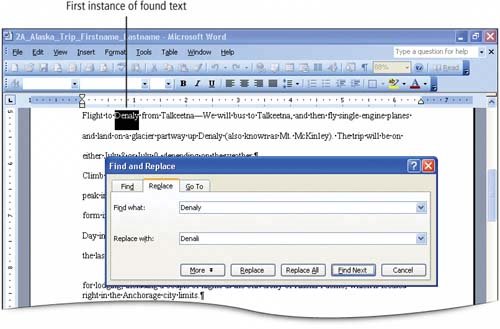
The first instance of Denaly is selected, and the Find and Replace dialog box remains open. |
|
4. |
Click the Replace button. |
|
5. |
Click the Replace button. |
|
6. |
Click OK to close the message box. In the Find and Replace dialog box, in the Find what box, type ATC Click Find Next two times, and then notice that the word Watch is highlighted because it contains the letters atc. |
|
7. |
Near the bottom of the Find and Replace dialog box, click More. Under Search Options, select the Match case check box, and then select the Find whole words only check box. |
|
|
|
|
8. |
In the Replace with box, delete the existing text, type The Alumni Travel Club and then compare your dialog box with Figure 2.18. Figure 2.18. 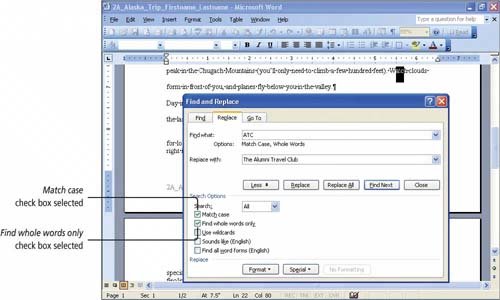
|
|
9. |
In the Find and Replace dialog box, click Replace All. |
|
10. |
Click OK, and then in the Find and Replace dialog box, click Close. Save |
Activity 2.8. Cutting, Copying, and Pasting Text
You can move text from one location in a document to a different location in the same document with the Cut and Paste commands. The Cut command moves text out of the document and onto the Office Clipboardthe temporary storage location for text or graphics. Then, use the Paste command to paste the contents of the Office Clipboard into the new location. The Copy command moves a copy of selected text onto the Office Clipboard, which you can then paste to another location. Unlike the Cut command, the Copy command does not remove the selected text from its original location.
|
1. |
In the upper portion of Page 1, locate the paragraph that begins All of the listed activities, and then double-click to select the word listed. |
|
2. |
On the Standard toolbar, click the Cut button NoteThe Difference Between Using Delete, Backspace, and Cut When you use the Cut command to remove text, it is moved onto the Office Clipboard and can be pasted into the sameor anotherdocument. When you use Delete or Backspace to remove text, the text is not moved onto the Office Clipboard. The only way you can retrieve text removed with Delete or Backspace is by using the Undo command. |
|
3. |
In the same line of text, click to position the insertion point between activities and below. On the Standard toolbar, click the Paste button |
|
4. |
Point to the Paste Options smart tag Figure 2.19. 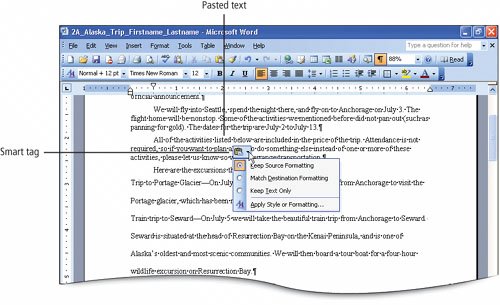
A short menu provides commands related specifically to the Paste command. You can determine whether you want to format the pasted text the same as the surrounding text or retain its original formatting. Performing another screen action will cancel the display of the smart tag; alternatively press  to cancel its display. to cancel its display. |
|
|
|
|
5. |
Click anywhere in the document to close the Paste Options menu and retain the same formatting. |
|
6. |
Locate the paragraph that begins We will fly into Seattle, hold down |
|
7. |
On the Standard toolbar, click the Cut button Alert!: If the Clipboard Task Pane Opens The Clipboard task pane might display on your screen depending on the options that have been set for the Office Clipboard on your computer. If the Clipboard task pane opens, click the Close button on the task pane title bar. |
|
8. |
Locate the paragraph that begins Last month and drag to select The Alumni Travel Club. On the Standard toolbar, click the Copy button |
|
9. |
Locate the short paragraph that begins Here are the excursions and select we have. On the Standard toolbar, click the Paste button Figure 2.20. 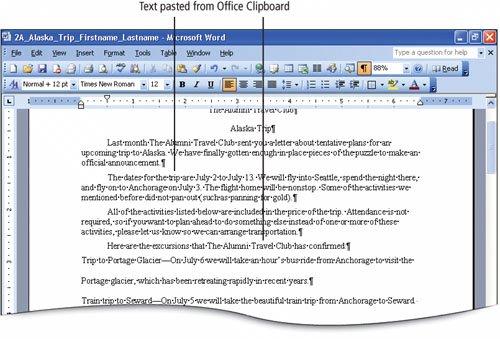
|
|
10. |
Save |
More Knowledge: Using the Office Clipboard Task Pane
If you use the Copy command two times without pasting, the Clipboard task pane may open. This enables you to copy up to 24 pieces of text, graphics, and other objects onto the Office Clipboard, and then paste them by selecting the desired item from the task pane. Clipboard task pane options are accessed by clicking the Options button at the bottom of the task pane. The Clipboard task pane can also be opened by clicking Edit on the menu bar, and then clicking Office Clipboard.
Activity 2.9. Dragging Text to a New Location
Another method of moving text is the drag-and-drop technique, which uses the mouse to drag selected text from one location to another. This method is useful if the text to be moved is on the same screen as the destination location.
|
1. |
Press |
|
2. |
Point to the selected words to display the Figure 2.21. 
NoteActivating the Drag-and-Drop Option If you do not see the |
|
|
|
|
3. |
Hold down the left mouse button and drag to the right until the dotted vertical line that floats next to the pointer is positioned to the right of the word puzzle and then release the left mouse button. Compare your screen with Figure 2.22. Figure 2.22. 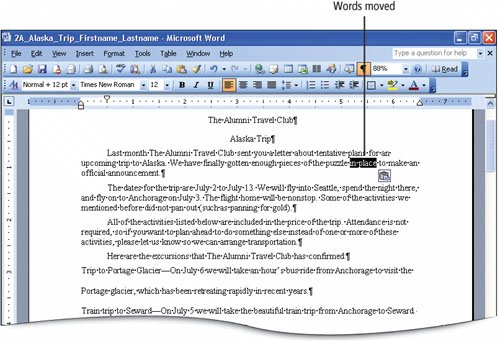
The words are moved to the insertion point location. The vertical line of the pointer assists you in dropping the moved text in the place where you want it. The small box attached to the pointer indicates that there is text attached to the pointer. |
|
4. |
Press |
|
5. |
Hold down |
|
6. |
Point to the selected sentence to display the Figure 2.23. 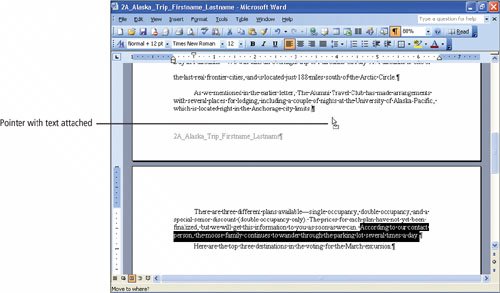
|
|
7. |
Release the mouse button. The sentence you moved becomes the last sentence in the paragraph. Notice that a space was automatically added before the sentence. |
Activity 2.10. Undoing and Redoing Changes
You can Undo one or more actions that you made to a document since the last time you saved it. An Undo action can be reversed with the Redo command.
|
1. |
On the Standard toolbar, click the Undo button The sentence you dragged and dropped returns to its original location as shown in Figure 2.24. Figure 2.24. 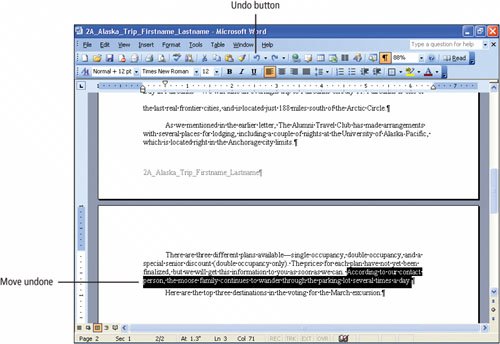
|
|
2. |
On the Standard toolbar, click the Undo button |
|
3. |
On the Standard toolbar, click the Redo button |
|
|
|
|
4. |
On the Standard toolbar, click the arrow on the right of the Undo button Figure 2.25. 
A list of changes displays showing all of the changes made since your last save operation. From the displayed list, you can click any of the actions and undo it, but all of the changes above the one you select will also be undone. |
|
5. |
Click anywhere in the document to close the Undo menu without selecting any actions. |
|
6. |
On the Standard toolbar, click the Redo button |
Activity 2.11. Inserting a Non-Breaking Space
When you want to keep two words together regardless of where they fall in a paragraph, use a non-breaking space, which will wrap both words even if only the second word would normally wrap to the next line. For example, if the words Mt. McKinley fall at the end of a line so that Mt. is on one line and McKinley moves to the next, inserting a non-breaking space will treat the two words as one so that they are not split between two lines.
|
1. |
Move to the top of the document. Locate the paragraph that begins All of the activities listed, and then click to position the insertion point at the end of the paragraph. |
|
2. |
Press |
|
|
|
|
3. |
Click to position the insertion point after the s in Focus and press Figure 2.26. 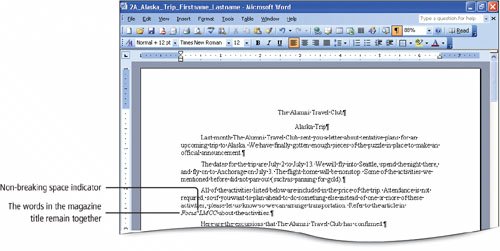
This combination of keys inserts a non-breaking space. The result is that the two words are treated as one word, so when Word applies its word wrapping rules, the two words are kept together on the same line. The non-breaking space is indicated by an open circle rather than the dot normally used to indicate a space. |
|
4. |
Save More Knowledge: Non-Breaking Hyphens To keep hyphenated words together, use a non-breaking hyphen in place of a standard hyphen. To insert a non-breaking hyphen, press |
Activity 2.12. Entering a Line Break
You can end a line of text and move to a new line without creating a new paragraph. This is accomplished with the manual line break, which moves the insertion point to the next line without creating a new paragraph. For example, if your paragraph style includes space before or after paragraphs, you might want to begin a new line without adding the space.
|
|
|
|
1. |
Press |
|
2. |
On the Formatting toolbar, click the Bold button |
|
3. |
In the first line, click anywhere in the text The Alumni Travel Club. From the Format menu, display the Paragraph dialog box and notice that under Spacing, 12 pt spacing is applied After the paragraph. Click Cancel to close the dialog box without making any changes. |
|
4. |
Press |
|
5. |
Click Undo Figure 2.27. 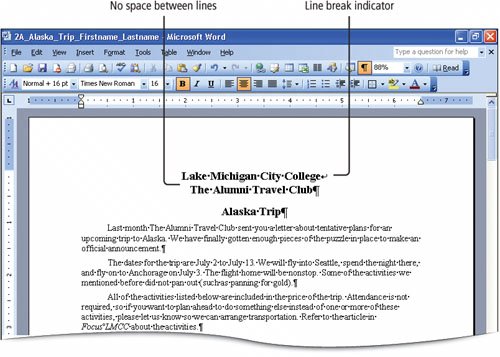
By using a manual line break, the 12 pt spacing after the paragraph is not inserted, because a new paragraph is not created; rather, a new line within the same paragraph is created. The bent arrow at the end of the first line indicates an inserted line break. |
|
6. |
Save |
Objective 3 Create and Modify Lists |
Windows XP
- Chapter One. Getting Started with Windows XP
- Project 1A. Windows XP
- Objective 1. Get Started with Windows XP
- Objective 2. Resize, Move, and Scroll Windows
- Objective 3. Maximize, Restore, Minimize, and Close a Window
- Objective 4. Create a New Folder
- Objective 5. Copy, Move, Rename, and Delete Files
- Objective 6. Find Files and Folders
- Objective 7. Compress Files
- Summary
- Key Terms
- Concepts Assessments
Outlook 2003
- Chapter One. Getting Started with Outlook 2003
- Getting Started with Microsoft Office Outlook 2003
- Project 1A. Exploring Outlook 2003
- Objective 1. Start and Navigate Outlook
- Objective 2. Read and Respond to E-mail
- Objective 3. Store Contact and Task Information
- Objective 4. Work with the Calendar
- Objective 5. Delete Outlook Information and Close Outlook
- Summary
- Key Terms
- Concepts Assessments
- Skill Assessments
- Performance Assessments
- Mastery Assessments
- Problem Solving
- GO! with Help
Internet Explorer
- Chapter One. Getting Started with Internet Explorer
- Getting Started with Internet Explorer 6.0
- Project 1A. College and Career Information
- Objective 1. Start Internet Explorer and Identify Screen Elements
- Objective 2. Navigate the Internet
- Objective 3. Create and Manage Favorites
- Objective 4. Search the Internet
- Objective 5. Save and Print Web Pages
- Summary
- Key Terms
- Concepts Assessments
- Skill Assessments
- Performance Assessments
- Mastery Assessments
- Problem Solving
Computer Concepts
- Chapter One. Basic Computer Concepts
- Objective 1. Define Computer and Identify the Four Basic Computing Functions
- Objective 2. Identify the Different Types of Computers
- Objective 3. Describe Hardware Devices and Their Uses
- Objective 4. Identify Types of Software and Their Uses
- Objective 5. Describe Networks and Define Network Terms
- Objective 6. Identify Safe Computing Practices
- Summary
- In this Chapter You Learned How to
- Key Terms
- Concepts Assessments
Word 2003
Chapter One. Creating Documents with Microsoft Word 2003
- Chapter One. Creating Documents with Microsoft Word 2003
- Getting Started with Microsoft Office Word 2003
- Project 1A. Thank You Letter
- Objective 1. Create and Save a New Document
- Objective 2. Edit Text
- Objective 3. Select, Delete, and Format Text
- Objective 4. Create Footers and Print Documents
- Project 1B. Party Themes
- Objective 5. Navigate the Word Window
- Objective 6. Add a Graphic to a Document
- Objective 7. Use the Spelling and Grammar Checker
- Objective 8. Preview and Print Documents, Close a Document, and Close Word
- Objective 9. Use the Microsoft Help System
- Summary
- Key Terms
- Concepts Assessments
- Skill Assessments
- Performance Assessments
- Mastery Assessments
- Problem Solving
- You and GO!
- Business Running Case
- GO! with Help
Chapter Two. Formatting and Organizing Text
- Formatting and Organizing Text
- Project 2A. Alaska Trip
- Objective 1. Change Document and Paragraph Layout
- Objective 2. Change and Reorganize Text
- Objective 3. Create and Modify Lists
- Project 2B. Research Paper
- Objective 4. Insert and Format Headers and Footers
- Objective 5. Insert Frequently Used Text
- Objective 6. Insert and Format References
- Summary
- Key Terms
- Concepts Assessments
- Skill Assessments
- Performance Assessments
- Mastery Assessments
- Problem Solving
- You and GO!
- Business Running Case
- GO! with Help
Chapter Three. Using Graphics and Tables
- Using Graphics and Tables
- Project 3A. Job Opportunities
- Objective 1. Insert and Modify Clip Art and Pictures
- Objective 2. Use the Drawing Toolbar
- Project 3B. Park Changes
- Objective 3. Set Tab Stops
- Objective 4. Create a Table
- Objective 5. Format a Table
- Objective 6. Create a Table from Existing Text
- Summary
- Key Terms
- Concepts Assessments
- Skill Assessments
- Performance Assessments
- Mastery Assessments
- Problem Solving
- You and GO!
- Business Running Case
- GO! with Help
Chapter Four. Using Special Document Formats, Columns, and Mail Merge
- Using Special Document Formats, Columns, and Mail Merge
- Project 4A. Garden Newsletter
- Objective 1. Create a Decorative Title
- Objective 2. Create Multicolumn Documents
- Objective 3. Add Special Paragraph Formatting
- Objective 4. Use Special Character Formats
- Project 4B. Water Matters
- Objective 5. Insert Hyperlinks
- Objective 6. Preview and Save a Document as a Web Page
- Project 4C. Recreation Ideas
- Objective 7. Locate Supporting Information
- Objective 8. Find Objects with the Select Browse Object Button
- Project 4D. Mailing Labels
- Objective 9. Create Labels Using the Mail Merge Wizard
- Summary
- Key Terms
- Concepts Assessments
- Skill Assessments
- Performance Assessments
- Mastery Assessments
- Problem Solving
- You and GO!
- Business Running Case
- GO! with Help
Excel 2003
Chapter One. Creating a Worksheet and Charting Data
- Creating a Worksheet and Charting Data
- Project 1A. Tableware
- Objective 1. Start Excel and Navigate a Workbook
- Objective 2. Select Parts of a Worksheet
- Objective 3. Enter and Edit Data in a Worksheet
- Objective 4. Construct a Formula and Use the Sum Function
- Objective 5. Format Data and Cells
- Objective 6. Chart Data
- Objective 7. Annotate a Chart
- Objective 8. Prepare a Worksheet for Printing
- Objective 9. Use the Excel Help System
- Project 1B. Gas Usage
- Objective 10. Open and Save an Existing Workbook
- Objective 11. Navigate and Rename Worksheets
- Objective 12. Enter Dates and Clear Formats
- Objective 13. Use a Summary Sheet
- Objective 14. Format Worksheets in a Workbook
- Summary
- Key Terms
- Concepts Assessments
- Skill Assessments
- Performance Assessments
- Mastery Assessments
- Problem Solving
- You and GO!
- Business Running Case
- GO! with Help
Chapter Two. Designing Effective Worksheets
- Designing Effective Worksheets
- Project 2A. Staff Schedule
- Objective 1. Use AutoFill to Fill a Pattern of Column and Row Titles
- Objective 2. Copy Text Using the Fill Handle
- Objective 3. Use AutoFormat
- Objective 4. View, Scroll, and Print Large Worksheets
- Project 2B. Inventory Value
- Objective 5. Design a Worksheet
- Objective 6. Copy Formulas
- Objective 7. Format Percents, Move Formulas, and Wrap Text
- Objective 8. Make Comparisons Using a Pie Chart
- Objective 9. Print a Chart on a Separate Worksheet
- Project 2C. Population Growth
- Objective 10. Design a Worksheet for What-If Analysis
- Objective 11. Perform What-If Analysis
- Objective 12. Compare Data with a Line Chart
- Summary
- Key Terms
- Concepts Assessments
- Skill Assessments
- Performance Assessments
- Mastery Assessments
- Problem Solving
- You and GO!
- Business Running Case
- GO! with Help
Chapter Three. Using Functions and Data Tables
- Using Functions and Data Tables
- Project 3A. Geography Lecture
- Objective 1. Use SUM, AVERAGE, MIN, and MAX Functions
- Objective 2. Use a Chart to Make Comparisons
- Project 3B. Lab Supervisors
- Objective 3. Use COUNTIF and IF Functions, and Apply Conditional Formatting
- Objective 4. Use a Date Function
- Project 3C. Loan Payment
- Objective 5. Use Financial Functions
- Objective 6. Use Goal Seek
- Objective 7. Create a Data Table
- Summary
- Key Terms
- Concepts Assessments
- Skill Assessments
- Performance Assessments
- Mastery Assessments
- Problem Solving
- You and GO!
- Business Running Case
- GO! with Help
Access 2003
Chapter One. Getting Started with Access Databases and Tables
- Getting Started with Access Databases and Tables
- Project 1A. Academic Departments
- Objective 1. Rename a Database
- Objective 2. Start Access, Open an Existing Database, and View Database Objects
- Project 1B. Fundraising
- Objective 3. Create a New Database
- Objective 4. Create a New Table
- Objective 5. Add Records to a Table
- Objective 6. Modify the Table Design
- Objective 7. Create Table Relationships
- Objective 8. Find and Edit Records in a Table
- Objective 9. Print a Table
- Objective 10. Close and Save a Database
- Objective 11. Use the Access Help System
- Summary
- Key Terms
- Concepts Assessments
- Skill Assessments
- Performance Assessments
- Mastery Assessments
- Problem Solving Assessments
- Problem Solving
- You and GO!
- Business Running Case
- GO! with Help
Chapter Two. Sort, Filter, and Query a Database
- Sort, Filter, and Query a Database
- Project 2A. Club Fundraiser
- Objective 1. Sort Records
- Objective 2. Filter Records
- Objective 3. Create a Select Query
- Objective 4. Open and Edit an Existing Query
- Objective 5. Sort Data in a Query
- Objective 6. Specify Text Criteria in a Query
- Objective 7. Print a Query
- Objective 8. Specify Numeric Criteria in a Query
- Objective 9. Use Compound Criteria
- Objective 10. Create a Query Based on More Than One Table
- Objective 11. Use Wildcards in a Query
- Objective 12. Use Calculated Fields in a Query
- Objective 13. Group Data and Calculate Statistics in a Query
- Summary
- Key Terms
- Concepts Assessments
- Skill Assessments
- Performance Assessments
- Mastery Assessments
- Problem Solving
- You and GO!
- Business Running Case
- GO! with Access Help
Chapter Three. Forms and Reports
- Forms and Reports
- Project 3A. Fundraiser
- Objective 1. Create an AutoForm
- Objective 2. Use a Form to Add and Delete Records
- Objective 3. Create a Form Using the Form Wizard
- Objective 4. Modify a Form
- Objective 5. Create an AutoReport
- Objective 6. Create a Report Using the Report Wizard
- Objective 7. Modify the Design of a Report
- Objective 8. Print a Report and Keep Data Together
- Summary
- Key Terms
- Concepts Assessments
- Skill Assessments
- Performance Assessments
- Mastery Assessments
- Problem Solving
- You and GO!
- Business Running Case
- GO! with Help
Powerpoint 2003
Chapter One. Getting Started with PowerPoint 2003
- Getting Started with PowerPoint 2003
- Project 1A. Expansion
- Objective 1. Start and Exit PowerPoint
- Objective 2. Edit a Presentation Using the Outline/Slides Pane
- Objective 3. Format and Edit a Presentation Using the Slide Pane
- Objective 4. View and Edit a Presentation in Slide Sorter View
- Objective 5. View a Slide Show
- Objective 6. Create Headers and Footers
- Objective 7. Print a Presentation
- Objective 8. Use PowerPoint Help
- Summary
- Key Terms
- Concepts Assessments
- Skill Assessments
- Performance Assessments
- Mastery Assessments
- Problem Solving
- You and GO!
- Business Running Case
- GO! with Help
Chapter Two. Creating a Presentation
- Creating a Presentation
- Project 2A. Teenagers
- Objective 1. Create a Presentation
- Objective 2. Modify Slides
- Project 2B. History
- Objective 3. Create a Presentation Using a Design Template
- Objective 4. Import Text from Word
- Objective 5. Move and Copy Text
- Summary
- Key Terms
- Concepts Assessments
- Skill Assessments
- Performance Assessments
- Mastery Assessments
- Problem Solving
- You and GO!
- Business Running Case
- GO! with Help
Chapter Three. Formatting a Presentation
- Project 3A. Emergency
- Objective 1. Format Slide Text
- Objective 2. Modify Placeholders
- Objective 3. Modify Slide Master Elements
- Objective 4. Insert Clip Art
- Project 3B. Volunteers
- Objective 5. Apply Bullets and Numbering
- Objective 6. Customize a Color Scheme
- Objective 7. Modify the Slide Background
- Objective 8. Apply an Animation Scheme
- Summary
- Key Terms
- Concepts Assessments
- Skill Assessments
- Performance Assessments
- Mastery Assessments
- Problem Solving
- You and GO!
- Business Running Case
- GO! with Help
Integrated Projects
Chapter One. Using Access Data with Other Office Applications
- Chapter One. Using Access Data with Other Office Applications
- Introduction
- Project 1A. Meeting Slides
- Objective 1. Export Access Data to Excel
- Objective 2. Create a Formula in Excel
- Objective 3. Create a Chart in Excel
- Objective 4. Copy Access Data into a Word Document
- Objective 5. Copy Excel Data into a Word Document
- Objective 6. Insert an Excel Chart into a PowerPoint Presentation
Chapter Two. Using Tables in Word and Excel
- Chapter Two. Using Tables in Word and Excel
- Introduction
- Project 2A. Meeting Notes
- Objective 1. Plan a Table in Word
- Objective 2. Enter Data and Format a Table in Word
- Objective 3. Create a Table in Word from Excel Data
- Objective 4. Create Excel Worksheet Data from a Word Table
Chapter Three. Using Excel as a Data Source in a Mail Merge
- Chapter Three. Using Excel as a Data Source in a Mail Merge
- Introduction
- Project 3A. Mailing Labels
- Objective 1. Prepare a Mail Merge Document as Mailing Labels
- Objective 2. Choose an Excel Worksheet as a Data Source
- Objective 3. Produce and Save Merged Mailing Labels
- Objective 4. Open a Saved Main Document for Mail Merge
Chapter Four. Linking Data in Office Documents
- Chapter Four. Linking Data in Office Documents
- Introduction
- Project 4A. Weekly Sales
- Objective 1. Insert and Link in Word an Excel Object
- Objective 2. Format an Object in Word
- Objective 3. Open a Word Document That Includes a Linked Object, and Update Links
Chapter Five. Creating Presentation Content from Office Documents
EAN: 2147483647
Pages: 448







 to position the insertion point at the beginning of the document.
to position the insertion point at the beginning of the document. your changes.
your changes. . Alternatively, right-click on the selected text and click Cut from the shortcut menu; or, press
. Alternatively, right-click on the selected text and click Cut from the shortcut menu; or, press  . Alternatively, right-click in the desired area and click Paste from the shortcut menu; or, press
. Alternatively, right-click in the desired area and click Paste from the shortcut menu; or, press  until its ScreenTip Paste Options displays, click its arrow, and then compare your screen with Figure 2.19.
until its ScreenTip Paste Options displays, click its arrow, and then compare your screen with Figure 2.19. , and then in the sentence that begins The dates for the trip, click to select the entire sentence.
, and then in the sentence that begins The dates for the trip, click to select the entire sentence. to remove the space at the end of the paragraph. Click to position the insertion point at the beginning of the paragraph, and then click the Paste button
to remove the space at the end of the paragraph. Click to position the insertion point at the beginning of the paragraph, and then click the Paste button  . Alternatively, right-click on the selected text and click Copy from the shortcut menu; or, press
. Alternatively, right-click on the selected text and click Copy from the shortcut menu; or, press  pointer as shown in Figure 2.21.
pointer as shown in Figure 2.21. to move to the end of the document. Then, scroll up as necessary so that you can view the last three paragraphs on your screenthis will include the bottom of Page 1 and the top of Page 2.
to move to the end of the document. Then, scroll up as necessary so that you can view the last three paragraphs on your screenthis will include the bottom of Page 1 and the top of Page 2. .
. .
. once, and then type Refer to the article in Focus LMCC about the activities. Notice that Focus LMCC, which is the name of a magazine, is split between two linesFocus is on one line and LMCC wrapped to the next line.
once, and then type Refer to the article in Focus LMCC about the activities. Notice that Focus LMCC, which is the name of a magazine, is split between two linesFocus is on one line and LMCC wrapped to the next line. to delete the space. While holding down both
to delete the space. While holding down both  , press
, press  . Compare your screen with Figure 2.26.
. Compare your screen with Figure 2.26. . This is especially useful to avoid splitting a telephone number between two lines of text.
. This is especially useful to avoid splitting a telephone number between two lines of text. pointer in the left margin area, drag down to select the first two lines of textthe two title lines.
pointer in the left margin area, drag down to select the first two lines of textthe two title lines. . On the Formatting toolbar, click the Font Size arrow
. On the Formatting toolbar, click the Font Size arrow  , and then click 16.
, and then click 16. . Notice the spacing after the paragraph.
. Notice the spacing after the paragraph.